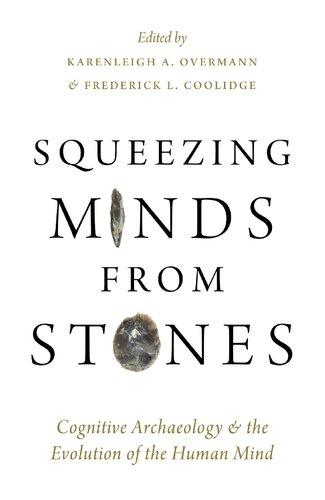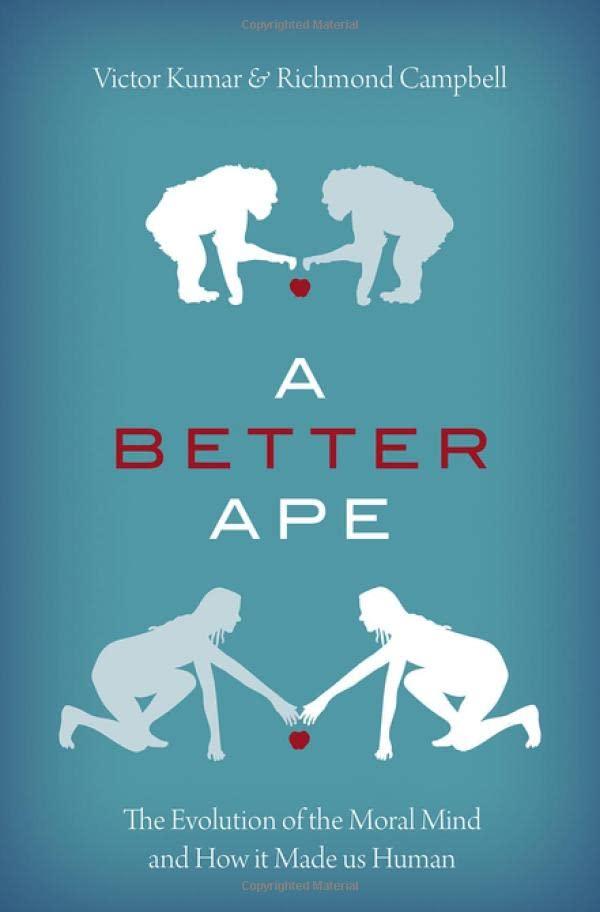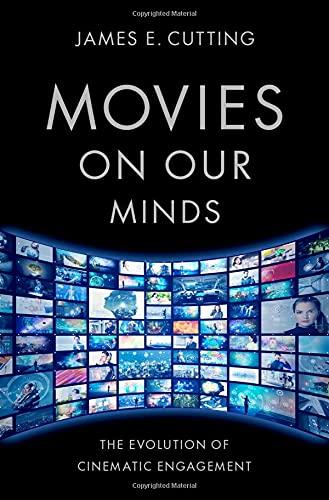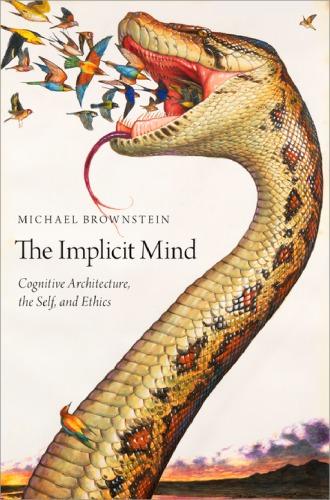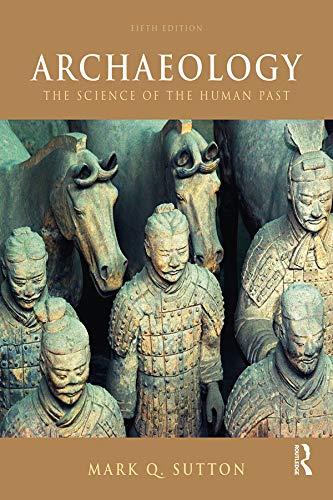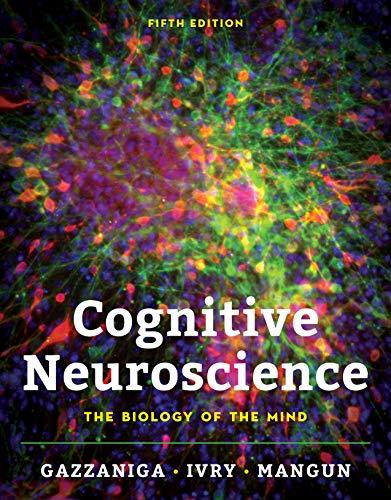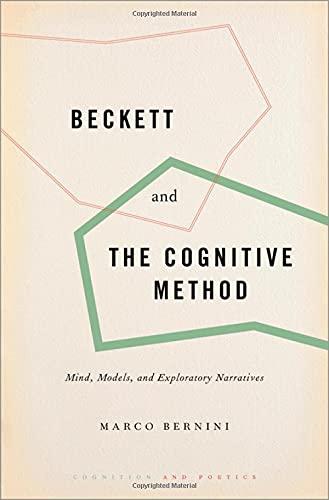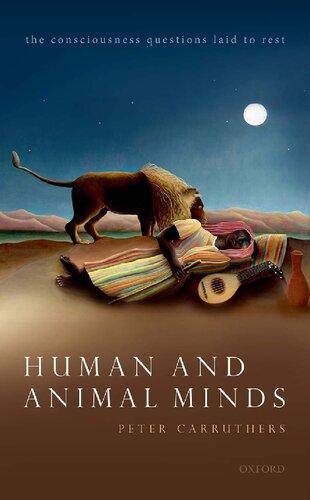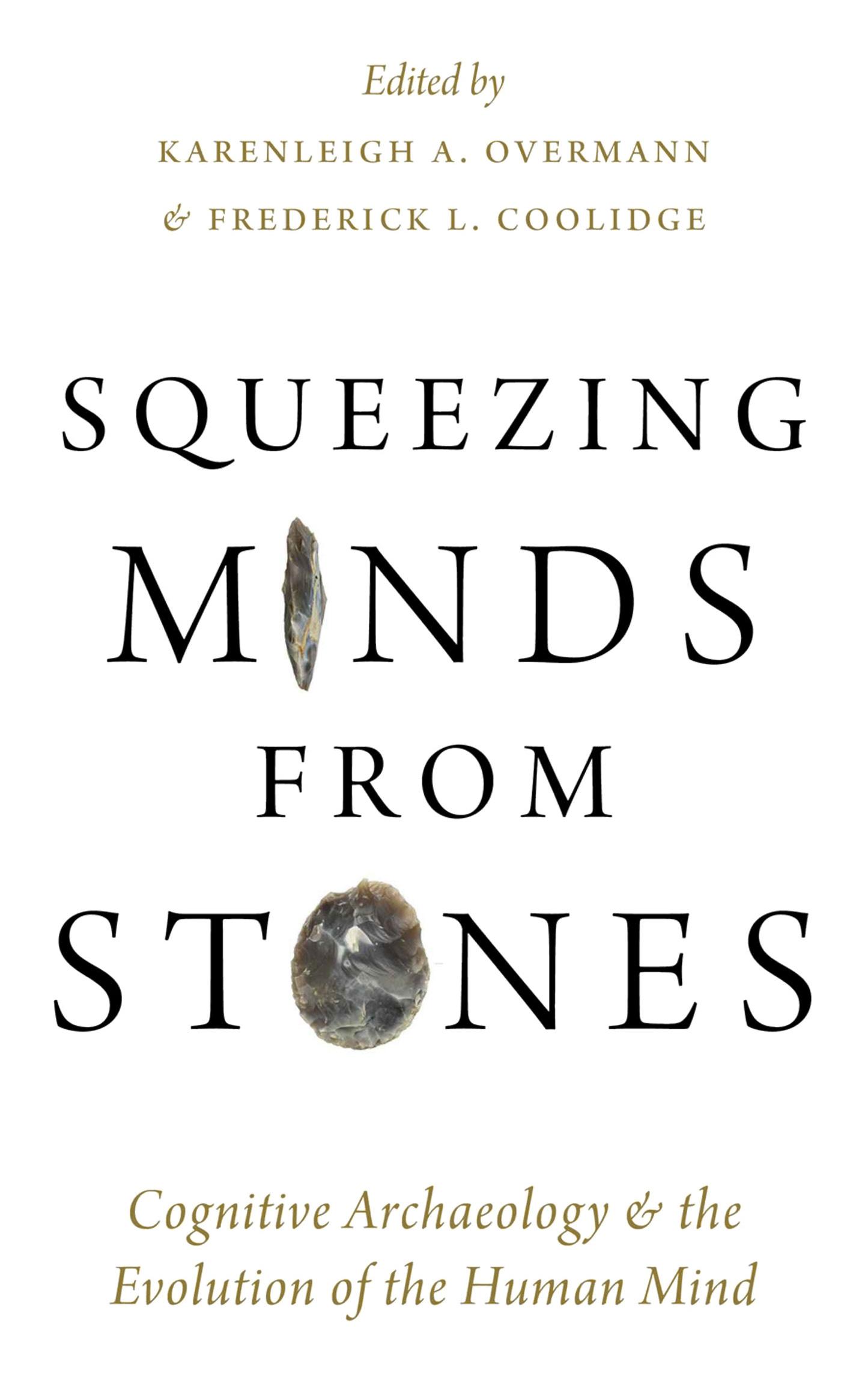Squeezing Minds From Stones
Cognitive Archaeology and the Evolution of the Human Mind
Edited by Karenleigh A. Overmann and Frederick L. Coolidge
Oxford University Press is a department of the University of Oxford. It furthers the University’s objective of excellence in research, scholarship, and education by publishing worldwide. Oxford is a registered trade mark of Oxford University Press in the UK and certain other countries.
Published in the United States of America by Oxford University Press 198 Madison Avenue, New York, NY 10016, United States of America.
© Oxford University Press 2019
All rights reserved. No part of this publication may be reproduced, stored in a retrieval system, or transmitted, in any form or by any means, without the prior permission in writing of Oxford University Press, or as expressly permitted by law, by license, or under terms agreed with the appropriate reproduction rights organization. Inquiries concerning reproduction outside the scope of the above should be sent to the Rights Department, Oxford University Press, at the address above.
You must not circulate this work in any other form and you must impose this same condition on any acquirer.
CIP data is on file at the Library of Congress ISBN 978–0–19–085461–4
1 3 5 7 9 8 6 4 2
Printed by Sheridan Books, Inc., United States of America
CONTENTS
Contributors vii
Introduction: Cognitive Archaeology at the Crossroads 1
Karenleigh A. Overmann and Frederick L. Coolidge
1. A Simian View of the Oldowan: Reconstructing the Evolutionary Origins of Human Technology 13
William C. McGrew, Tiago Falótico, Michael D. Gumert, and Eduardo B. Ottoni
2. Homo artifex: An Extended Evolutionary Perspective on the Origins of the Human Mind, Brain, and Culture 42
Dietrich Stout
3. Looking at Rocks Together: Tool Production, Joint Attention, and Offline Cognition 59
Rex Welshon
4. Evolution of Cognitive Archaeology through Evolving Cognitive Systems: A Chapter for Tom Wynn 79
Iain Davidson
5. Sticks, Stones, and the Origins of Sapience 102
Philip J. Barnard
6. The Origin of Cumulative Culture: Not a Single-Trait Event But Multifactorial Processes 128
Miriam Noël Haidle
7. Hominin Evolution and Stone Tool Scavenging and Reuse in the Lower Paleolithic 149
Adam Brumm, Matt Pope, Mathieu Leroyer, and Kate Emery
8. Flake-Making and the “Cognitive Rubicon”: Insights from Stone-Knapping Experiments 179
Mark W. Moore
9. Stone Tools and Spatial Cognition 200
Derek Hodgson
10. Testing Models of Handedness in Stone Tools 225
Natalie Uomini and Lana Ruck
11. Early Convergent Cultural Evolution: Acheulean Giant Core Methods of Africa 237
Gonen Sharon
12. Cultural Transmission from the Last Common Ancestor to the Levallois Reducers: What Can We Infer? 251 Stephen J. Lycett
13. The Handaxe Aesthetic 278 Thomas Wynn and Tony Berlant
14. The Stories Stones Tell of Language and Its Evolution 304 Shelby S. Putt
15. In Three Minds: Extending Cognitive Archaeology with the Social Brain 319 Cory Stade and Clive Gamble
16. The Evolution of Social Transmission in the Acheulean 332 Ceri Shipton
17. Knapping in the Dark: Stone Tools and a Theory of Mind 355
James Cole
18. A Critical Analysis of the Evidence for Sexual Division of Tasks in the European Upper Paleolithic 376 Sophie A. de Beaune
19. The Enhanced Working Memory Model: Its Origin and Development 406 Frederick L. Coolidge
20. Materiality and the Prehistory of Number 432 Karenleigh A. Overmann
21. Ensnaring the Mind: Cognitive Implications of Setting Snares and Traps 457 Lyn Wadley
22. On the Minds of Bow Hunters 473
Marlize Lombard
23. Epilogue: Situating the Cognitive in Cognitive Archaeology 497 Thomas Wynn
Index 505
CONTRIBUTORS
Philip J. Barnard
Honorary Member
Medical Research Council Cognition and Brain Sciences Unit University of Cambridge, UK
Tony Berlant, artist Santa Monica, USA
Adam Brumm
Associate Professor
Australian Research Centre for Human Evolution
Environmental Futures Research Institute
Griffith University, Australia
James Cole
Principal Lecturer
School of Environment and Technology University of Brighton, UK
Frederick L. Coolidge
Professor Department of Psychology University of Colorado Colorado Springs, USA
Iain Davidson
Emeritus Professor of Archaeology University of New England, Australia
Sophie A. de Beaune
Professor
Jean Moulin Lyon 3 University
Faculté des Lettres et Civilisations, Lyon, and UMR 7041 “Archéologies et Sciences de l’Antiquité,” Nanterre, France
Kate Emery
Institute of Archaeology University College London England, UK
Tiago Falótico
Postdoctoral Researcher Institute of Psychology University of São Paulo, Brazil
Clive Gamble
Emeritus Professor Centre for the Archaeology of Human Origins
Department of Archaeology University of Southampton, UK
Michael D. Gumert
Associate Professor Division of Psychology School of Social Sciences Nanyang Technological University, Singapore
Miriam Noël Haidle
Scientific Coordinator Research Center “The Role of Culture in Early Expansions of Humans— ROCEEH” of the Heidelberg Academy of Sciences and Humanities, Senckenberg Forschungsinstitut und Naturmuseum, and Institut für Ur- und Frühgeschichte und Archäologie des Mittelalters, Abt. Ältere Urgeschichte und Quartärökologie, Cognitive Archaeology Unit Tübingen, Germany
Derek Hodgson
Adjunct Professor
Department of Archaeology
University of York, UK
Mathieu Leroyer
Département d’Histoire de l’art et archéologie (UFR03)
Université de Paris 1
Panthéon- Sorbonne France
Marlize Lombard
Professor
Centre for Anthropological Research/ Palaeo-Research Institute
University of Johannesburg, South Africa
Stephen J. Lycett
Associate Professor
Department of Anthropology (Laboratory for Evolutionary Anthropology and Anthropological Archaeology)
The State University of New York (SUNY), USA
William C. McGrew
Honorary Professor School of Psychology and Neuroscience University of St. Andrews, Scotland, UK
Mark W. Moore
Associate Professor Archaeology and Palaeoanthropology
University of New England, Armidale, Australia
Eduardo B. Ottoni
Professor Institute of Psychology University of São Paulo, Brazil
Karenleigh A. Overmann
MSCA Research Fellow
Department of Psychosocial Science
University of Bergen, Norway
Matt Pope
Principal Research Fellow
Institute of Archaeology
University College London England, UK
Shelby S. Putt
Postdoctoral Researcher
The Stone Age Institute and The Center for Research into the Anthropological Foundations of Technology
Indiana University, USA
Lana Ruck
Doctoral Student
Cognitive Science Program; Department of Anthropology
Indiana University, USA
Gonen Sharon
Associate Professor
Multidisciplinary Studies, Tel Hai College
Upper Galilee, Israel
Ceri Shipton Faculty Member
Centre of Excellence for Australian Biodiversity and Heritage
Australian National University, Australia
Cory Stade Visiting Fellow
Centre for the Archaeology of Human Origins University of Southampton, UK
Dietrich Stout
Associate Professor Department of Anthropology, Emory University
Atlanta, USA
Natalie Uomini Researcher
Department of Linguistic and Cultural Evolution
Max Planck Institute for the Science of Human History
Jena, Germany
Lyn Wadley
Honorary Professor
Evolutionary Studies Institute
University of the Witwatersrand, South Africa
Rex Welshon
Professor
Department of Philosophy University of Colorado Colorado Springs, USA
Thomas Wynn Distinguished Professor Department of Anthropology and UCCS Center for Cognitive Archaeology University of Colorado Colorado Springs, USA
INTRODUCTION
COGNITIVE ARCHAEOLOGY AT THE CROSSROADS
Karenleigh A. Overmann and Frederick L. Coolidge
Sometime in the fall of 1974, a graduate student named Thomas Wynn walked across the campus of the University of Illinois at Champaign-Urbana, deep in thought as he mulled over potential projects for his doctoral research in Early Stone Age/Lower Paleolithic archaeology. Suddenly, the research possibility that popped into his mind quite literally stopped him in his tracks, mid-quad. Months earlier, in the spring semester, his doctoral supervisor, anthropologist Charles Keller, had given him the name of psychologist Jean Piaget and tasked him with assessing whether Piaget’s ideas about cognitive development in children were of any use to an archaeologist. At the time, Wynn had concluded that there was no way to apply psychological theory to the archaeological record. But now, he was powerfully struck by the thought that Piaget’s ideas on the ontogenetic development of cognitive abilities might explain how human cognition had evolved, as discerned through change in the forms of stone tools.
The idea that human cognitive evolution could be understood from stone tools— the only things that remain over the millions of years separating us from our earliest tool-using ancestors, apart from a few bones, either theirs or ones they modified—was perhaps something of a Zeitgeist in the 1970s, a reaction to the rigid materialism that characterized the “processual archaeology” advocated by the “new archaeologists” a decade earlier. Certainly, floating around the University of Illinois campus were ideas by Lewis Binford (1962, 1972; Binford & Binford, 1968) and pro-structuralist concepts of culture and science from Claude Lévi- Strauss (1962) and Edmund Leach (1973). In fact, similar ideas were emerging on both sides of the Atlantic, not only in the work of Wynn but also that of his contemporaries, scholars like archaeologists Glynn Isaac, Colin Renfrew, John Gowlett, and Iain Davidson, psychologist William Noble, evolutionary primatologist William McGrew, biological anthropologist Sue Taylor Parker, and evolutionary neurobiologist Kathleen Gibson.
The central challenge then, as it remains today, for an archaeology interested in cognition was this: How might every last bit of data be squeezed from the archaeological record and used to understand evolutionary change in human cognition, with the daunting goal of resolving the ages-old mystery, how did we become human? The inquiry is particularly challenging, not merely because of the vagaries that perplex any archaeological interpretation, but because those interpretations necessarily involve theoretical frameworks, definitions, assumptions, methods, and models that come from outside archaeology. Cognitive abilities had to be understood in
psychological terms in order to operationalize them as behaviors whose traces might be archaeologically detectible. As a result, cognitive archaeology was no relatively straightforward matter of discovery and description, but an interdisciplinary endeavor that increasingly needed to know and apply things about how psychological constructs might be operationalized so that they could be detected as change in material forms. Included in this endeavor was examination of the ways in which neuroanatomy and neurofunctionality change over ontogenetic and evolutionary spans of time and how this relates to material change, and philosophical speculations about the nature of cognition, concepts, and symbols and the possible role of materiality in such phenomena.
Cognitive archaeology might be called the not-so-simple art of squeezing minds from stones—not coincidentally the title we have chosen for this volume. To introduce it, we first look briefly at the work of some of the pioneers of cognitive archaeology, and use it to demonstrate how, some four decades later, many of the same concerns and challenges still remain, though new theoretical frameworks and methodological techniques have been adopted to address them. Then we outline the book’s contributions, which we have divided into four parts: general cognitive evolution, stone tools and the mind, social cognition, and more recent cognition (things like numbers, weapons, and trapping). Our contributors include many of the scholars who helped establish cognitive archaeology as a research inquiry, as well as some emerging scholars. This range reflects change in the discipline itself, which is still pondering unresolved questions like language origins, incorporating approaches such as neuroimaging, and broadening demographics such as gender (more women) and specialty (primate archaeology and modern art). We conclude the volume with the thoughts of one of the pioneers, Thomas Wynn, on the future of cognitive archaeology.
THE BEGINNINGS OF COGNITIVE ARCHAEOLOGY: A REACTION TO PROCESSUALISM
Processual archaeology demanded that interpretation be guided by theory, something that remains a continuing mandate. Yet it also provided something to react against, its insistence that the past be interpreted strictly according to the material evidence. As Leach (1973) expressed it, archaeology was ill-equipped to study ancient peoples: “. . . all the ingenuity in the world will not replace the evidence that is lost and gone for ever,” and “. . . you should recognize your guesses for what they are” (p. 768). Nonetheless, processualism had also opened up the possibility that the archaeological record could be informative not just about the artifacts themselves, the discover-and-describe mandate of earlier schools of archaeological thought, but also regarding the lifestyles of those who made and used them. As Renfrew (1982) would later note, “inferring intelligent behavior from its material relics” was something only archaeology could do (p. 4). Admittedly, these were matters requiring new approaches and theoretical frameworks, longer chains of inference, and, occasionally, bigger leaps of faith than might fit comfortably with the injunction for a no-nonsense scientism. Binford (2001), for example, had introduced the idea that the archaeological record could be understood by gaining insights from contemporary hunter-gatherer societies. Such ethnic explanations would quickly be criticized (if not rejected outright) because
3 Introduction: Cognitive Archaeology at the Crossroads
modern traditional societies are hardly prehistoric—as Smith (1955) expressed it, such comparisons demonstrated only “what an incredible variety of codes of behaviour in fact actuate human conduct” (p. 5)—and therefore do not provide valid comparisons to societies that were, either in form or dignity. One of Binford’s contemporaries, anthropologist Ralph Holloway (1969), was grappling with the similarly difficult and still unresolved question of between-species comparability: How special is humanity in comparison to non-human species? How might concepts like culture and cultural transmission be defined? And should such definitions be broad enough to show continuities between humans and non-human species or so narrowly construed that discontinuities emphasized human uniqueness?
In responding to the whiff of revolution in the air while expanding on some of these processual ideas, Thomas Wynn focused his doctoral research on change in lithic technologies—the Oldowan, Acheulean, and Levallois industries—over a span of about two million years, published as “The Intelligence of Later Acheulean Hominids” in Man (1979), and later as The Evolution of Spatial Competence (1989). Wynn used Piagetian developmental theory as his framework for explaining how changes in material form revealed evolutionary change in hominin spatial cognition and intelligence. The evidentiary, theoretical, and investigative scopes were narrowly drawn: They included lithic change, Piaget’s developmental framework, human capacities for spatiality and intelligence, and little else. Essentially, increasing complexity in material form was an index for the emergence of new and increasingly complex psychological capabilities, a spectrum of evolutionary change that originated in continuity (an endpoint that was decidedly ape-like) and reached discontinuity (an endpoint anchored in the unique cognitive complexity of modern humans). Wynn would later team up with evolutionary primatologist William McGrew (Wynn & McGrew, 1989) to explore further the idea that human discontinuity had originated in an ape-like continuity. They compared the Oldowan industry to tool use by modern apes (especially chimpanzees), arguing that the capabilities required for the former fell within the range demonstrated by the latter, with the possible exceptions of carrying objects for longer distances and competing for food with large carnivores. Here they addressed the minimum necessary competence, the idea that as tools reflect only the lower boundary of the capabilities required for their production and use, they are likely to underestimate either the actual or potential cognitive abilities of their makers. This concept would become a mantra for Wynn, one he has passed on to his collaborators and students: Make no more assumptions than necessary for explaining a phenomenon.
Also working in North America but independently from Wynn, Sue Taylor Parker and Kathleen Gibson (1979) were attacking the problem from a slightly different angle. Rather than operationalizing a cognitive ability like spatial cognition and then looking for its traces in material change, they examined the origins of intelligence and language through ontogenetic development in cognition and evolutionary change in brain size. While thoroughly Piagetian in their orientation toward ontogenetic development, they nonetheless held the phylogenetic part of Piaget’s theory at arm’s length, calling his evolutionary model “Lamarckian and vitalistic” (p. 400). Their attempted compromise was comparing and finding parallels between four stages in the evolution of intellectual abilities for human children (Piaget’s ontogenetic theory) and various primate groups—prosimians, Old World monkeys, great apes, and hominids— species whose differentiation was apparently based on non-Piagetian evolutionary
criteria.1 Positing tool use as the sine non qua of hominid intelligence, they included a panoramic number of contributing factors in their model of how tool use developed, including cooperation, shared attention, diet, hunting, sociality and social structures, food sharing and transportation, shelter construction and use, climate, and available environmental resources. Individuals able to acquire more resources through cognitive advantages in domains such as planning were thought to have been favored by both natural and social selection: more likely to survive, acquire mates, and perpetuate their advantageous behavioral skills and cognitive traits through cultural and genetic mechanisms.
At about the same time but halfway across the globe in East Africa, Glynn Isaac (1976) was analyzing material complexity in the archaeological record and deriving conclusions about human evolution. He identified early tools and some dependence on their use for subsistence as falling outside the range of modern apes. Like Wynn, he stuck close to artifacts and their properties, but where Wynn had construed cognitive change from morphological change, Isaac focused on what morphological properties might indicate about the transport of raw materials, modification and use of finished tools, and cultural differences between groups. Isaac incorporated evidence on fossils and diet, types of interdisciplinary data whose inclusion has since become fairly common in cognitive archaeology. Also unlike Wynn (at least at this period), Isaac was willing to speculate about language, a topic as controversial and undecided then as it is today. He took the economic behaviors and adaptive patterns associated with tool use (e.g., modes of subsistence that included preying on local fauna and establishing a home base from which to scavenge, things that suggested groups were cooperating to obtain and share food resources like meat) to be windows on information exchange and the emergence of language (Isaac & Isaac, 1975).
In Australia, Iain Davidson and William Noble (1989) were also taking up the challenge of language, further helping to resurrect language origins as an archaeological inquiry. Recognizing the need to find ways of detecting traces of language origins and development in the archaeological record, they hypothesized that language had originated in depictive images that had themselves originated in gesture. During the Upper Paleolithic, gestures recreating the shapes of objects like bison had yielded parietal art that represented bison, which in turn had yielded reflexivity on the meaning of bison, and such reflexivity to words for them. Basically, language required understanding an object’s meaning, a mental leap from depiction to reference that assumed significant discontinuity in the way humans and non-human species construct, understand, and share social meanings. This approach differed from that being followed
1 Whether Parker and Gibson (1979) were completely successful in rejecting Piaget’s phylogenetic theory is debatable, given that their compromise ended up comparing evolutionary change in primates with Piaget’s ontogenetic stages of cognitive development. The parallels the authors inferred between Piaget’s sensorimotor period (birth to 2 years), preoperations period (2–7 years), concrete operations period (7–12 years), and formal operations period (12 years and thereafter) and what they called a prosimian stage, Old-World monkey stage, great ape stage, and hominid stage still equated prosimians with human infants, monkeys with human toddlers, and so on, characterizations that, while perhaps not as disparaging as similar parallels drawn to human societies by nineteenth-century theorists, remain inaccurate nonetheless.
in two related avenues of language origins research: the idea that language originated in gesture (the gestural origins hypothesis; Corballis, 1999; Gentilucci & Corballis, 2006), not as a transition to reference, as Davidson and Noble had argued, but as a communicative modality in itself, and the idea that language originated in tool use (Bradshaw & Nettleton, 1982; Higuchi, Chaminade, Imamizu, & Kawato, 2009), which recognized the neural and combinatorial similarities of language and the motor movements associated with tool behaviors. Davidson and Noble also doubted that culture could exist without language, a question that in recent decades has been answered with a resounding yes, since socially learned behaviors have also been demonstrated by non-human primates and cetaceans, species that presumably lack communication capabilities on par with human speech (Laland & Janik, 2006). Davidson and Noble also claimed that handaxes were the unintended results of repetitive behaviors rather than the deliberate imposition of shape enabled by increasingly complex spatial abilities, as had been argued by Wynn.
Davidson and Noble’s (1989) idea that inchoate concepts were given form as material substances were manipulated and were recognized perhaps only after the formative act complemented the philosophical turn developing in Britain, where Colin Renfrew (1982) was working to create a “cognitive processualism.” Renfrew disagreed that hominid cognitive evolution could be understood through Piagetian theory, the “old and dangerous principle that ontogeny follows phylogeny” (p. 14) and its converse, that phylogeny follows ontogeny. He also rejected processual elements such as the insistence that “an explanation can only be decently ‘scientific’ if expressed in the form of a universal law” (p. 10), while continuing the processual tradition of prioritizing objectivity and elaborating the processual idea that material forms were informative of how their makers had lived, to examine how and perhaps even what they had thought. In an archaeology of the mind, intelligent behavior could be recognized in the material forms found archaeologically, since material culture had an active role in constituting cultural reality. Archaeologists were being set free to interpret artifacts like stone cubes from Mohenjo-daro, a site of the Indus Valley civilization, as weights that implied both a system of conceptual mapping and the social conditions associated with it (Renfrew, 1982). Renfrew also noted that a cognitive archaeology would necessarily overlap with other disciplines—human psychology and neurophysiology, social and physical anthropology, comparative studies with other species, and even artificial intelligence, and needed coherent theory and sound analytical procedures to guide its inferences. Further, he recognized that the Cartesian distinction between mind and matter was problematic, an idea that would later inspire the even more philosophically oriented material engagement theory of cognitive archaeologist Lambros Malafouris (2013), which incorporates concepts from philosophy of mind.
Also in Britain, and sticking very close to the artifacts themselves as Wynn was doing, John Gowlett (1979, 1984) was focusing on the evolution of design form in lithic technologies. He suggested that analyzing a skill such as stone knapping (as reflected in finished artifacts) might be a fruitful way to approach cognitive evolution. Accordingly, he outlined biface manufacture as a complex process that included not only the series of strike decisions and strikes, but the selection and transport of raw material and the use of the tool as well. Gowlett agreed that handaxes showed an increase in cognitive complexity but argued, against Wynn, that it was a matter of standardization, not one of coordinating multiple visuospatial perspectives. He
proposed the end-to-end process to be so complex that it exceeded the capacity of modern non-human primates, even as early as the Oldowan (something Wynn and colleague William McGrew would argue against in 1989). Gowlett further suggested that handaxes and cleavers reflected concepts in the minds of their makers, some kind of mental template that guided the imposition of form, which was at odds with the idea of concepts becoming tangible and appreciable in new ways through material engagement (Malafouris, 2010b, 2013). Gowlett also noted that human cognition was likely not understood well enough in ways that would enable characterization of the continuities and discontinuities with other species, particularly the hominid adaptation to the intergenerational accumulation and transmission of experience (in other words, culture).
In this volume, the 22 chapters from our contributors develop many of the same themes raised in the formative decade of cognitive archaeology: the validity and use of ethnoarchaeological and experimental methods; the question of continuities and discontinuities between humans and non-human species; the selection and application of theoretical frameworks, including the displacement of Piagetian theory by contemporary psychological and neuroscientific approaches to brain function and form; the incorporation of interdisciplinary data; the origin of language; the ability of construing intentionality from artifactual form; the philosophical turn in cognitive archaeology; and the riddle of intergenerational accumulation and transmission. And, of course, still with us is the desire to wring every last bit of possible data out of stone tools, as well as more recent technologies like bows and arrows or traps and snares.
FORTY YEARS AFTER: CONTEMPORARY COGNITIVE ARCHAEOLOGY
Despite the rejection of Binford’s hunter-gatherer comparisons, today ethnoarchaeological and experimental approaches remain vibrant modes of understanding traditional and ancient technologies and the cognitive processes they involve, as extrapolated from the behaviors and brains of modern humans and non-human species. For example, in Chapter 18 in this volume, Sophie de Beaune uses ethnographic data from contemporary hunter-gatherers in Australia, Africa, and the Arctic. She does not equate their gendered division of labor to that construed for prehistoric peoples but, rather, uses it to demonstrate that archaeological analyses of gender are often skewed by researchers’ own cultural expectations. This has since been exemplified by the surprise greeting of last year’s announcement that a Viking grave, identified as that of a warrior because it contained weapons and horse bones, belonged in fact to a female and not a man, whose sex was recently identified through DNA analysis of her remains (Hedenstierna-Jonson et al., 2017). And as an example of the experimental approach, Mark Moore applies his personal wealth of flintknapping experience to the problem of construing intent in lithic remains: What does a modified stone tell us—if anything—about what its ancient maker intended when he or she knocked rocks together to produce flakes and perhaps refine them? How much of a goal is involved in making an artifact like a handaxe: Does it require a mental template that guides production by visualizing the end product, or is it simply the unintended consequence of exhausting a core, much as Davidson and Noble argued in the 1980s? And what light, if any, can experiments performed by modern stone-knappers shed on ancient intent
7 Introduction: Cognitive Archaeology at the Crossroads to realize artifactual form? Shelby Putt’s contribution on language (discussed later) also falls into the experimental category.
Holloway’s concern with between-species comparability foreshadowed what is now a substantial interest in comparative analyses, particularly with non-human primates and especially in regard to their tool use and the transmission and reproduction of learned behaviors. William McGrew, Tiago Falótico, Michael Gumert, and Eduardo Ottoni extend this line of inquiry by reviewing a wide range of studies in primate archaeology, now a distinct subdiscipline of archaeology (Haslam et al., 2009, 2017). Unlike experiments with captive apes (e.g., Kanzi; Savage-Rumbaugh, Toth, & Schick, 2007), primate archaeology focuses on tool use in natural situations, conditions more directly comparable to those of early hominids. These authors compare the tools produced by apes and Old and New World monkeys to early lithic technologies like the Oldowan industry, further updating work by Wynn and McGrew (Wynn, Hernandez-Aguilar, Marchant, & McGrew, 2011; Wynn & McGrew, 1989). One key difference in tool-use behaviors is the degree to which tools are reused. Nonhuman primates often make new tools whenever one is needed (e.g., chimpanzee termite-fishing probes), and when they reuse tools like anvils for cracking open foods like shellfish and nuts, they do so one at a time. These behaviors have several effects. First, tools are not used by more than one individual at a time, limiting potential opportunities for engaging cognitive processes like joint attention, something Rex Welshon explores in his chapter. Second, the tools do not accumulate modifications, either because they are created to fulfill a need and discarded once they have been used to satisfy it or because, like an anvil, their form does not become refined and hence does not act to accumulate social knowledge. The question of what it takes to accumulate and transmit culture between generations is addressed by Stephen Lycett and Miriam Noël Haidle in their respective chapters.
For its part, Piagetian theory has fallen out of fashion, particularly in the phylogenetic aspects presciently rejected by Parker and Gibson. If Piagetian phylogenesis was “Lamarckian and vitalistic” (Parker & Gibson, 1979, p. 400), his ontogenetic theory applied to archaic, traditional, and industrialized societies had the effect of dividing them into adults and children (Piaget, 1928), characterizations as unpalatable as they are inaccurate. More current theoretical frameworks on psychological capabilities have been adopted in cognitive archaeology. An example is the working memory model of Baddeley and Hitch (1974), brought to his decades-long collaboration with Thomas Wynn by Frederick Coolidge and recapped in his contribution to this volume. Consistent with the turn toward contemporary psychological theory, Thomas Wynn and Tony Berlant explore the neuroaesthetics of art, something that can be seen developing in the increasing incorporation of symmetric forms in lithic technologies. The chapter by Wynn and Berlant recounts “the great handaxe junket,” their five-year mission to seek the world’s most compelling handaxes, as judged by their respective archaeological and artistic sensibilities; the exhibit opened in January 2018 at the Nasher Sculpture Center in Dallas (Farago, 2018). Derek Hodgson examines developments in spatial cognition, as discerned from change in the form of stone tools, using insights from the neuroscience of visuospatial memory, visuomotor control, attention, and planning. James Cole offers a similar examination of change in lithic form, arguing that it illuminates developments in the construct known as theory of mind, the ability to know that others have minds whose content can differ from one’s own.
Modeling the mind and its evolutionary development continue to pose a challenge, especially as interdisciplinary data are brought to bear on the question. Philip Barnard looks at behaviors like tool use and their effects on mental and neural systems, differentiated in humans and non-human primates by developments in abilities like propositional meaning that underlie mental states, perception, and bodily control. He reviews the interacting cognitive subsystems (ICS) model, which enables mental capabilities to be analyzed and compared across extant species and the evolutionary development of human cognition. Dietrich Stout focuses on the continued incorporation of theory and methods capable of analyzing how organisms interact with their environments over time: Darwinian and neo-Darwinian evolutionary theory, Dunbar’s social brain hypothesis, technical intelligence hypothesis, niche construction theory, phenotypic accommodation, and gene–culture co-evolution. With a more personal retrospective, Iain Davidson looks back at how cognitive archaeologists approached stone tools during the formative decade, finding pre-processual influences from as early as the nineteenth century. He uses chaîne opératoire analysis, comparisons with nonhuman primate tool use, and Barnard’s cognitive subsystem model to argue for newer, more productive methods. One such method is the Budapest model of evolving cognitive systems (ECS), which seeks to understand ancestral cognitive states through comparative studies; the goal is to avoid modeling ancestral cognition as incomplete or deficient (e.g., as lacking language, which modern cognition includes), much as extant species are assumed competent (though alinguistic).
Language origins remains a topic of significant interest. Shelby Putt applies another experimental approach, the use of neuroimaging to see what parts of the brain are activate when someone flintknaps. Her focus is not how much intent is needed to realize form but rather to understand whether and to what extent the motor movements involved in flintknapping might overlap that of language. She notes Wynn’s (1991) reminder that attempts to find the origins of language in tool behaviors must be justified theoretically and, to the extent practicable, empirically if they are to be plausible and persuasive. Putt notes that in modern knappers, instruction by means of language rather than silent imitation affects which parts of the brain become active in replicating early stone tools. The idea is that specific overlaps between the neural activation patterns for language and stone knapping is taken as supporting the hypothesis of common origin. In comparison, Cory Stade and Clive Gamble approach the question of language origins through theory of mind. Their hypothesis is that somewhere during the long prehistory of stone tool production, silent imitation alone became insufficient for reproducing artifacts with the complexity of the prepared core techniques; language instruction would have been needed for its transmission. These authors analyze the tool as a “third partner” that enables joint attention and shared understanding on the part of both teacher and student, a critical development in cognition (see Rex Welshon’s chapter) and cumulative culture (see the chapters by Stephen Lycett and Miriam Noël Haidle).
The philosophical turn is represented here by several scholars. Karenleigh Overmann analyzes prehistoric numerical cognition. After reviewing the evolution of contributing abilities like quantity perception, she examines the archaeological record of Mesopotamia for the first unambiguous numbers, the role of material forms for counting in them, and what change in such material forms might suggest about possible archaeological signs and timelines for even earlier periods. This discussion
9 Introduction: Cognitive Archaeology at the Crossroads is underpinned by material engagement theory (MET), the theoretical framework of cognitive archaeologist Lambros Malafouris (2010a, 2013; Malafouris & Renfrew, 2010). MET views the mind as not just embodied and embedded (cognition is affected by being in a body and situated in an environment) but also extended (material forms are not just causally linked to cognition but a constitutive component of it), enacted (cognition is the interaction of brains, bodies, and behaviors), and evolving (humans have by no means reached a terminal cognitive state). Overmann takes Malafouris’ idea that “tools make minds” to suggest that change in material forms indexes change in behaviors and psychological processes. Marlize Lombard similarly looks at how tools co-create and transform behaviors, bodies, and brains. Mark Moore emphasizes the embodied and enactive aspects of stone knapping: The “decision about where to place the next blow, and how much force to use, is not taken by the knapper in isolation; it is not even processed internally. The flaking intention is constituted, at least partially, by the stone itself . . . [which], like the knapper’s body, is an integral and complementary part of the intention to knap” (Malafouris, 2010b, p. 17). And Rex Welshon brings analytic philosophy to bear on key attributes of joint attention, such as its reflexivity, symmetry, and transitivity.
While all the contributions in this volume use the archaeological record to illuminate the ancient mind, some adhere more closely to stone tools, the material form with the greatest longevity and hence the best potential for illuminating the deepest prehistory of human cognitive evolution. In this vein is the contribution by Adam Brumm, Matt Pope, Mathieu Leroyer, and Kate Emery. These authors analyze scavenging and reuse in Lower Paleolithic stone tools, as demonstrated through their analysis of weathering and patina effects. Natalie Uomini and Lana Ruck compare and contrast three hypotheses on why the human species is so strongly right-handed—matters of social learning, fighting, or task complexity that might intensify right-handedness or maintain a minority of left-handers. These authors then speculate on how the various hypotheses might be examined and substantiated through archaeological analyses. Gonen Sharon examines the independent development of giant core techniques by distinct Acheulean populations separated by most of the African continent. He proposes their similarities as an instance of convergent evolution, with different groups converging on similar solutions to questions of technology and design in response to identical social needs and purposes. Ceri Shipton looks at what stone tools reveal about over-imitation, the tendency to recreate actions when knapping stone, whether those actions are causally efficacious or not. He then analyzes this evidence for what it can tell us about social transmission and the necessity for some of the instruction to take the form of language.
Finally, what complex technologies can reveal about cognitive change concerns the last two chapters of the volume. In her contribution, Marlize Lombard focuses on compound technologies like the bow and arrow as an index for change in cognitive plasticity, which she defines as human abilities for teaching and learning from one another, innovating both behaviorally and technologically, and responding flexibly and creatively when novel or complex situations are encountered. Lyn Wadley offers a similar analysis of snares and traps, which require and therefore imply cognitive abilities like planning and inhibition (i.e., delayed gratification). This illuminates the need for inferential argumentation posed by the lack of direct archaeological evidence. Traps and snares are not archaeologically attested, presumably because they were
made of perishable materials. Rather, they are suggested by demographic differences in faunal remains (e.g., more bones than expected from species difficult to hunt because of size, speed, and habits). Such indirect evidence requires the use of so-called bridging arguments, statements that link archaeological findings to the conditions producing them, especially as understood through ethnoarchaeological comparisons and experimental data.
ACKNOWLEDGMENTS
For acting as our external reviewers, we thank Stephen Chrisomalis, Wayne State University, USA; Michael Chazan, University of Toronto, Canada; Robert Clowes, Universidade Nova de Lisboa, Portugal; Agustin Fuentes, University of Notre Dame, USA; Mick Gantley, University of Exeter, UK; John Gowlett, University of Liverpool, UK; Michael Haslam, University of Oxford, UK; Antonis Iliopoulos, School of Archaeology, University of Oxford, UK; Alastair Key, University of Kent, UK; Marc Kissel, University of Notre Dame, USA; Danielle Macdonald, University of Tulsa, USA; Manuel Martin-Loeches, Universidad Complutense de Madrid, España; Michael O’Brien, University of Missouri, USA; Eric Reuland, Universiteit Utrecht, Nederland; Patrick Roberts, Max Planck Institut, Deutschland; Enza Spinapolice, Università di Roma, Italia; Alexandra Sumner, DePaul University, USA; and Matthew Walls, University of Calgary, Canada.
Work on this volume was accomplished with the kind support and infinite patience of our families, and of course, the inspiration of our colleague, friend, and mentor, Thomas Wynn.
REFERENCES
Baddeley, A. D., & Hitch, G. J. (1974). Working memory. In G. H. Bower (Ed.), The psychology of learning and motivation: Advances in research and theory (Vol. 8, pp. 47–89). New York: Academic Press.
Binford, L. R. (1962). Archaeology as anthropology. American Antiquity, 28(2), 217–225.
Binford, L. R. (1972). An archaeological perspective. New York: Seminar Press.
Binford, L. R. (2001). Constructing frames of reference: An analytical method for archaeological theory building using ethnographic and environmental data sets. Berkeley, CA: University of California Press.
Binford, S. R., & Binford, L. R. (Eds.). (1968). New perspectives in archaeology. Chicago, IL: Aldine Publishing Company.
Bradshaw, J. L., & Nettleton, N. C. (1982). Language lateralization to the dominant hemisphere: Tool use, gesture and language in hominid evolution. Current Psychology, 2, 171–192.
Corballis, M. C. (1999). The gestural origins of language: Human language may have evolved from manual gestures, which survive today as a “behavioral fossil” coupled to speech. American Scientist, 87(2), 138–145.
Davidson, I., & Noble, W. (1989). The archaeology of perception: Traces of depiction and language. Current Anthropology, 30(2), 125–155.
Farago, J. (2018, February 2). Stone Age tools, or art? Or both? New York Times, p. C17. New York.
Gentilucci, M., & Corballis, M. C. (2006). From manual gesture to speech: A gradual transition. Neuroscience and Biobehavioral Reviews, 30(7), 949–960.
11 Introduction: Cognitive Archaeology at the Crossroads
Gowlett, J. A. J. (1979). Complexities of cultural evidence in the Lower and Middle Pleistocene. Nature, 278(5699), 14–17.
Gowlett, J. A. J. (1984). Mental abilities of early man: A look at some hard evidence. In R. Foley (Ed.), Hominid evolution and community ecology: Prehistoric human adaptation in biological perspective (pp. 167–192). London: Academic Press.
Haslam, M., Hernandez-Aguilar, R. A., Ling , V., Carvalho, S., De la Torre, I., DeStefano, A., . . . Warren, R. (2009). Primate archaeology. Nature, 460(7253), 339–344.
Haslam, M., Hernandez-Aguilar, R. A., Proffitt, T., Arroyo, A., Falótico, T., Fragaszy, D. M., . . . Luncz, L. V. (2017). Primate archaeology evolves. Nature Ecology and Evolution, 1, 1431–1437.
Hedenstierna‐Jonson, C., Kjellström, A., Zachrisson, T., Krzewińska, M., Sobrado, V., Price, N., . . . Storå, J. (2017). A female Viking warrior confirmed by genomics. American Journal of Physical Anthropology, 164(4), 853–860.
Higuchi, S., Chaminade, T., Imamizu, H., & Kawato, M. (2009). Shared neural correlates for language and tool use in Broca’s area. Neuroreport, 20(15), 1376–1381.
Holloway, R. L. (1969). Culture: A human domain. Current Anthropology, 10(4), 395–412.
Isaac, G. L. (1976). Stages of cultural elaboration in the Pleistocene: Possible archaeological indicators of the development of language capabilities. Annals of the New York Academy of Sciences, 280(1), 275–288.
Isaac, G. L., & Isaac, B. (1975). Africa. In R. L. Stigler (Ed.), Varieties of culture in the Old World (pp. 8–48). New York: St. Martins Press.
Laland, K. N., & Janik, V. M. (2006). The animal cultures debate. Trends in Ecology and Evolution, 21(10), 542–547.
Leach, E. R. (1973). Concluding address. In C. Renfrew (Ed.), The explanation of culture change: Models in prehistory. Proceedings of a meeting of the Research Seminar in Archaeology and Related Subjects held at the University of Sheffield, December 14–16, 1971 (pp. 761–771). London: Gerald Duckworth.
Lévi- Strauss, C. (1962). The savage mind (G. Weidenfield, Trans.). Chicago, IL: University of Chicago Press.
Malafouris, L. (2010a). Grasping the concept of number: How did the sapient mind move beyond approximation? In C. Renfrew & I. Morley (Eds.), The archaeology of measurement: Comprehending heaven, earth and time in ancient societies (pp. 35–42). Cambridge, UK: Cambridge University Press.
Malafouris, L. (2010b). Knapping intentions and the marks of the mental. In L. Malafouris & C. Renfrew (Eds.), The cognitive life of things: Recasting the boundaries of the mind (pp. 13–27). Cambridge, UK: McDonald Institute for Archaeological Research.
Malafouris, L. (2013). How things shape the mind: A theory of material engagement. Cambridge, MA: MIT Press.
Malafouris, L., & Renfrew, C. (2010). Introduction: The cognitive life of things: Archaeology, material engagement and the extended mind. In L. Malafouris & C. Renfrew (Eds.), The cognitive life of things: Recasting the boundaries of the mind (pp. 1–12). Cambridge, UK: McDonald Institute for Archaeological Research.
Parker, S. T., & Gibson, K. R. (1979). A developmental model for the evolution of language and intelligence in early hominids. Behavioral and Brain Sciences, 2, 367–408.
Piaget, J. (1928). Logique génétique et sociologie. Revue Philosophique de La France et de l’Étranger, 105, 167–205.
Renfrew, C. (1982). Towards an archaeology of mind: An inaugural lecture delivered before the University of Cambridge on 30th November 1982. Cambridge, UK: Cambridge University Press.
Savage-Rumbaugh, E. S., Toth, N. P., & Schick, K. D. (2007). Kanzi learns to knap stone tools. In D. A. Washburn (Ed.), Primate perspectives on behavior and cognition (pp. 279–291). Washington, DC: American Psychological Association.
Smith, M. A. (1955). The limitations of inference in archaeology. Archaeological News Letter, 6, 3–7.
Wynn, T. (1979). The intelligence of later Acheulean hominids. Man, 14, 371–391.
Wynn, T. (1989). The evolution of spatial competence. Chicago, IL: University of Illinois Press.
Wynn, T. (1991). Tools, grammar and the archaeology of cognition. Cambridge Archaeological Journal, 1(2), 191–206.
Wynn, T., Hernandez-Aguilar, R. A., Marchant, L. F., & McGrew, W. C. (2011). “An ape’s view of the Oldowan” revisited. Evolutionary Anthropology, 20(5), 181–197.
Wynn, T., & McGrew, W. C. (1989). An ape’s view of the Oldowan. Man, 24(3), 383–398.
A SIMIAN VIEW OF THE OLDOWAN RECONSTRUCTING THE EVOLUTIONARY ORIGINS OF HUMAN TECHNOLOGY
William C. McGrew, Tiago Falótico, Michael D. Gumert, and Eduardo B. Ottoni
INTRODUCTION
Question: Why model human origins? Answer: Because we have no choice. That is, until we devise a time machine that will take us back to the late Miocene, so that we can collect first-hand behavioral data from our earliest hominin ancestors, we must model them (Andrews, 2015). In the absence of such a tool, we must collect data on living species, either from living Homo sapiens or from other pertinent taxa, and use it to proxy an inferential reconstruction. If we seek referential models, then the first port of call should be other members of the order Primates, the more closely related to us the better. First choice on phylogenetic and genetic grounds should be those living creatures with whom we last shared a common ancestor, which are the two members of the extant genus Pan, bonobo (P. paniscus) and chimpanzee (P. troglodytes) (Gruber & Clay, 2016). If we are interested in the evolutionary origins of technology, then the starting point should be the latter, a prodigious tool-maker and tool-user, rather than the former, which shows paltry technology in nature (Haslam, 2014).
Tom Wynn realized this long ago. It is well worth the effort to reread his attempt to use Piagetian theory on the development of intelligence, applied to the Oldowan (Wynn, 1981). His daring assertion was that the Oldowan lithic industry required only preoperational intelligence, which is currently demonstrated in the elementary technology of living apes. He made clear his hypothesis: “The evolution of a uniquely hominid intelligence had not occurred by Oldowan times” (Wynn, 1981). Thus, comparative analyses of the stone artifacts of extinct, early hominins and the comparable products of the behavior of at least one African ape species should be informative and helpful.
On this basis, Wynn and McGrew (1989) collaborated on a systematic and detailed comparison of the tools of the Oldowan and the tools of living chimpanzees. They concluded that there was nothing exclusively human about the oldest known archaeological evidence, but acknowledged caveats about long-distance carriage of objects and competition with large carnivores for large prey. By 2010, we could not deny that the earlier effort was outdated, not just by abundant new knowledge of wild chimpanzees, but also by comparably impressive findings on wild orangutans,
Pongo species (spp.) (Meulman & van Schaik, 2013). (Equally notable was the continuing absence of such data on the habitual use of tools by the other two living taxa of African apes, the bonobo, and the gorilla, Gorilla spp.) Thus, an expanded update was needed, but not just among the hominoids; by then, impressive new data on elementary technology were emerging from monkeys. This was acknowledged but only minimally, in two brief, inserted boxes, one each for capuchin monkeys (Sapajus spp.) and long-tailed macaques (Macaca fascicularis) (Wynn, Hernandez-Aguilar, Marchant, & McGrew, 2011). Now, with findings from both Old (Malaivijitnond., Lekprayoon, Tandavanittj, Panha, Cheewatham, & Hamada, 2007) and New World monkeys (Ottoni, 2015) in natural settings, it seems likely that our early ideas about an “ape adaptive grade” are obsolete.
At the same time, when knowledge of the Oldowan expanded between what we knew in 1989 and 2011 (Toth & Schick, 2009; Whiten, Schick, & Toth, 2009), unexpected new Paleolithic phenomena emerged. The long-standing earliest evidence of flaked stone tools dating to 2.6 million years ago (Mya) and the search for the elusive Pre-Oldowan (Panger, Brooks, Richmond, & Wood, 2002) have been superseded by recent finds from West Turkana, Kenya. These were heralded by earlier finds of cut-marked bones at 3.39 Mya from Dikika, Ethiopia (McPherron et al., 2010), but those preliminary results have not yet been followed up. Meanwhile, Harmand and colleagues (2015) have presented lithic evidence for a new industry, the Lomekwian, from Lomekwi 3 at Lake Turkana at 3.3 Mya. It is too early to judge to what extent the Lomekwian relates to the Oldowan (Lewis & Harmand, 2016), either as precursor or otherwise, but such analyses are eagerly awaited.
Thus, the multiple aims of this chapter are to update the record on chimpanzee technology in nature, and to add exciting new data from both New World (mostly from the bearded capuchin, Sapajus libidinosus) and Old World (mostly from the Burmese long-tailed macaque, Macaca fascicularis aurea) monkeys. Finally, we seek to collate these various findings for comparison with the Oldowan, seeking a useful model for the evolutionary origins of human technology, in the spirit pioneered by Tom Wynn.
METHODS
Wynn and McGrew (1989) and Wynn and colleagues (2011) devised a framework for point-by-point comparison in two tables, one on tools and procedures (Table 1.1), and the other on tool uses and chaînes opératoires (Table 1.2). Table 1.1 had four topics: tool type, groupings of types, manufacturing, and associative tool use. Table 1.2 had six topics: target processed, mode of processing, site of processing, objects carried, distance carried, and chaînes opératoires. For purposes of direct comparison, we stick here to these established criteria pioneered by Wynn. We have retained 9 of the 10 topics; the last one, chaînes opératoires, was based on a single secondary reference (Haidle, 2010), seemed to be of limited utility, and was thus removed for our comparison here.
Both previous treatments (Wynn & McGrew, 1989, Wynn et al., 2011) employed simple binary (presence/absence) criteria for inclusion of evidence; readers could seek out primary data from references listed for most, but not all, topics. Thus, in Table 1.1, types of tools were referenced to source, but manufacturing processes were not. In Table 1.2, targets processed were referenced to source, but not modes of processing
Table 1.1. Tools and Their Characteristics for the Chimpanzee ( Pan troglodytes [ Pt ]), Burmese LongTailed Macaque ( Macaca fascicularis aurea [ Mfa ]), and
Bearded Capuchin ( Sapajus libidinosus [ Sl ])
Tool Characteristics Pt Reference (Pt) Mfa Reference (Mfa) Sl Reference (Sl)
C Canale, Guidorizzi, Kierulff, & Gatto, 2009; Falótico & Ottoni, 2016; Fragaszy, Izar, Visalberghi, Ottoni, & de Oliveira, 2004; Mendes et al., 2015; Moura & Lee, 2004; Ottoni & Mannu, 2001
Malaivijitnond, Lekprayoon., Tandavanittj, Panha., Cheewatham, & Hamada 2007; Gumert, Kluck, & Malaivijitnond, 2009; Gumert & Malaivijitnond, 2012, 2013; Haslam, Gumert, Biro, Carvalho, & Malaivijitnond, 2013; Tan, Tan, Vyas, Malaivijitnond, & Gumert, 2015, Tan 2017
C
BenitoCalvo, Carvalho, Arroyo, Matsuzawa, & de la Torre, 2015; Carvalho, 2011
C
What are types of tools?
C Canale et al., 2009; Falótico & Ottoni, 2016; Fragaszy et al., 2004; Mendes et al., 2015; Moura & Lee, 2004; Ottoni & Mannu, 2001
H Cutrim, 2013; Ottoni & Mannu, 2001
Malaivijitnond et al, 2007; Gumert et al., 2009; Gumert & Malaivijitnond, 2012, 2013; Haslam et al., 2013; Tan et al., 2015, Tan 2017
C BenitoCalvo et al., 2015; Carvalho, 2011 C
C Luncz, Mundry, & Boesch, 2012; Yamakoshi, 2011
C Falótico & Ottoni, 2016; Mendes et al., 2015; Ottoni & Mannu, 2001; Visalberghi, Haslam, Spagnoletti, & Fragaszy, 2013 ( continued )
Stone hammer
Stone anvil
Wooden hammer
C Luncz et al., 2012
Wooden anvil
Table 1.1. Continued
Reference (Sl)
H Falótico & Ottoni, 2014; Souto et al., 2011
Pt Reference (Pt) Mfa Reference (Mfa)
H O’Malley, Wallauer, Murray, & Goodall, 2012; Sanz & Morgan, 2011
C Boesch et al., 2016; Humle, Yamakoshi, & Matsuzawa, 2011; Koops, Schöning, Isaji, & Hashimoto, 2015
H Falótico & Ottoni, 2014; Mannu & Ottoni, 2009
Tool Characteristics
Flexible probe
Stiff probe
C Pruetz et al., 2015
H Hobaiter, Poisot, Zuberbühler, Hoppitt, & Gruber, 2014
C Sanz & Morgan, 2013
C Gumert, Kluck, & Malaivijitnond, 2009, Tan et al., 2015
C Liu, Fragaszy, & Visalberghi, 2016; Visalberghi, Addessi, et al., 2009
C Gumert et al., 2009; Gumert & Malaivijitnond, 2013
C Mannu & Ottoni, 2009: arthropod probe
Spear
Sponge
Penetrator, perforator
C Boesch & Boesch, 1984
Mollusc shell pick and hammer
How do tools vary?
Hammers reflect prey traits (e.g., nut hardness)
H Hobaiter et al., 2014: moss or leaf for sponge
Different raw materials used for same tool (e.g., bark, grass, vine, etc.)
C Mannu & Ottoni, 2009: stone for digging and pounding
C Gumert et al., 2009; Tan et al., 2015: stone for axe hammer and pound hammer
C McGrew, Tutin, & Baldwin, 1979: leaf for termite fishing probe and sponge
Same raw material used for varied tools
C Mannu & Ottoni, 2009
C Falótico & Ottoni, 2016; Falótico, Siqueira, & Ottoni, 2017
C Gumert & Malaivijitnond, 2013
C Falótico & Ottoni, 2014
H Gumert, Hoong, & Malaivijitnond, 2011
C Falótico & Ottoni, 2014; Fragaszy et al., 2004; Mannu & Ottoni, 2009; Ottoni & Mannu, 2001; Visalberghi et al., 2007; Visalberghi, Addessi, et al., 2009
C Falótico & Ottoni, 2014; Fragaszy et al., 2004; Mannu & Ottoni, 2009; Ottoni & Mannu, 2001
C Haslam, PascualGarrido, Malaivijitnond, & Gumert, 2016, Gumert & Malaivijitnond, 2013
C Proffitt et al., 2016: flake stone
C Falótico & Ottoni, 2014; Mannu & Ottoni, 2009
( continued )
C Sousa, 2011
Water access design varies with same raw material (e.g., leaves)
C Boesch et al., 2016; Carvalho, Matsuzawa, & McGrew, 2013
Raw materials selected by weight/ size for task
C Lonsdorf, 2005
C Luncz & Boesch, 2014; Luncz, Wittig, & Boesch, 2015
Sex differences in tool use
How are tools made?
Raw material selectivity
C PascualGarrido, Buba, Nodza, & Sommer, 2012
Transport (e.g., from source to site of use)
C Wynn, 1981
Simple topological spatial concepts (e.g., proximity, boundary, order, symmetry)
C Sanz, Morgan, & Gulick, 2004; Yamakoshi, 2011
Manual and oral modification
Table 1.1. Continued
C Liu et al., 2016; Proffitt et al., 2016
C Falótico & Ottoni, 2016
H Mannu & Ottoni, 2009
C Falótico & Ottoni, 2016; Fragaszy et al., 2004; Mannu & Ottoni, 2009; Mendes et al., 2015; Moura & Lee, 2004; Ottoni & Mannu, 2001
H Falótico & Ottoni, 2016
H Falótico & Ottoni, 2016
C Mannu & Ottoni, 2009: dig, hammer with pounding stone
Tool Characteristics Pt Reference (Pt)
C Carvalho, Biro, McGrew, & Matsuzawa, 2009
C Boesch et al., 2016; Carvalho et al., 2009
C Sousa, Biro, & Matsuzawa, 2009
C Gumert et al., 2009
C Malaivijitnond et al., 2007; Gumert et al., 2009; Gumert & Malaivijitnond, 2012, 2013; Haslam et al., 2013; Tan, et al., 2015, Tan 2017
Retouch
Reuse
Processing related to raw material type (e.g., detach, reduce, reshape, combine)
How are tools associated?
C Sanz & Morgan, 2013
C Sanz & Morgan, 2013
C Carvalho et al., 2012, 2013
C Sanz & Morgan, 2013
P Matsuzawa, 2011b
C Haslam, Luncz, et al., 2016
Kit
Set
Composite (e.g., hammer and anvil)
Crafted
Metatool
C Carvalho et al., 2012, 2013
C O’Malley et al., 2012: ant fish, termite fish with flexible probe
Assemblage
Multifunction
Note: Table compiled by authors. C, Customary; H, Habitual; P, Present.
Table 1.2. ToolUse Procedures for the Chimpanzee ( Pan troglodytes [ Pt ]), Burmese LongTailed Macaque ( Macaca fascicularis aurea [ Mfa ]), and Bearded
Capuchin ( Sapajus libidinosus [ Sl ])
P Souto et al., 2011
Falótico & Ottoni, 2014
Falótico & Ottoni, 2014; Mannu & Ottoni, 2009
P
C
C De Moraes, Souto, & Schiel, 2014; de Resende, Ottoni, & Fragaszy, 2008; Falótico & Ottoni, 2016; Fragaszy et al., 2004; Mannu & Ottoni, 2009; Moura & Lee, 2004; Ottoni & Mannu, 2001; Visalberghi et al., 2013, 2016
Gumert et al., 2009; Gumert & Malaivijitnond, 2012; Luncz et al., 2017; Falótico, Spagnoletti, Haslam, Luncz, Malaivijitnond, & Gumert, 2017, Proffitt, Luncz, Malaivijitnond, Gumert, Svensson, Haslam, 2018
Gumert & Malaivijitnond, 2012 C De Moraes et al., 2014; Falótico & Ottoni, 2016; Mannu & Ottoni, 2009
C
ToolUse Procedures Pt Reference (Pt)
C Sanz, Call, & Morgan, 2009; Sanz et al., 2004; Sanz & Morgan, 2011; Stewart & Piel, 2014
C PascualGarrido, Umaru, Allon, & Sommer, 2013
C Sanz & Morgan, 2009; Sommer, Buba, Jesus, & PascualGarrido, 2012
C Luncz et al., 2012
What is processed?
Termite mound, nest
Ant nest
Beehive (honey)
Nut
P
Hardshelled fruit, seed H McGrew, Marchant, Wrangham, & Klein, 1999
Falótico & Ottoni, 2014; Mannu & Ottoni, 2009 ( continued )
C
Gumert & Malaivijitnond, 2012
P
Vertebrate C Pruetz et al., 2015
